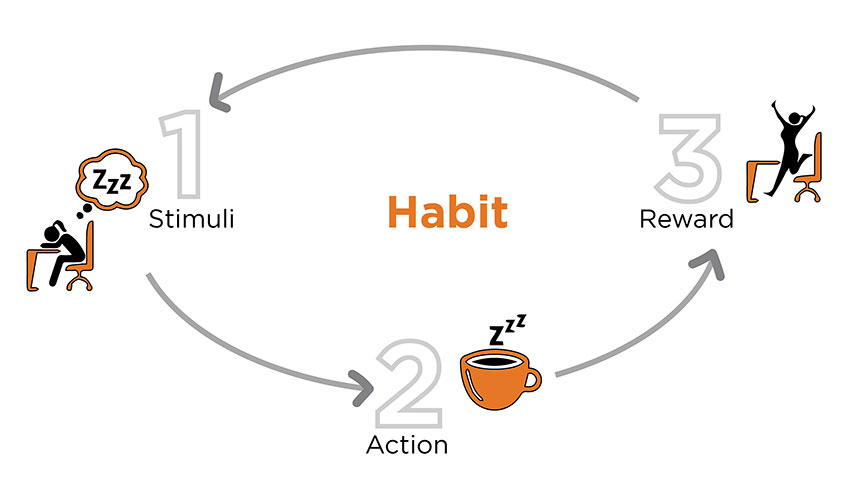Purchase behaviors are often recurring in nature and performed in specific places. Over time repetitive buying behaviors are less driven by goals and intentions leading us to develop purchase habits. When habits have been formed, environmental cues can activate practiced responses in the absence of conscious decision-making.
Purchase decisions can also be influenced by elements better understood as purchase drivers. These elements can prompt an automatic response resulting in purchase behavior. These include visibility, access, ease of purchase, communications, education, involvement, value/price, alignment and appeal, and personal values. All of these can be used to strategically drive sales both online and offline.
Understanding Habits
Habits are composed of 3 important constituents:


Stimuli: Contexts such as time, location, events, state of mind (e.g.: moods) or prior actions (e.g.: exercise) can trigger habit-driven responses. Contextual cues can include components of the physical or virtual environment that are present as an action or behavior gets repeated, for example, a specific sound, or fragrance.
Action: The process of doing something to achieve an end goal. For example, ordering a meal using an app. Ease to execute an action can motivate repeat actions and behaviors.
Reward: An incentive or a feature that encourages a repetitive action, and therefore very important in habit formations as it closes the loop. If the reward isn’t satisfying enough it can even act as a discouragement to an existing habit. For example, A ‘free’ chocolate with every meal ordered using an app may serve as an incentive to order more meals or can even discourage a repeat action for someone with diabetes.
Why is it Important to Understand Purchase Habits?
To promote the repetition of consumer transactions with your business, understanding the general construct of habits can be very insightful. The reasons to purchase can be logical, based on the risk and benefit factors, or simply emotional, impulsive, or even intuitive.
In the path-to-purchase, most consumers will begin with researching the product or service, comparing specifications, prices and evaluating competitors before making a purchase, but as logical as the process may sound, the current research in consumer behaviors has shown that most purchases happen in the so-called micro-moments.
It is true that the logical side of consumers craves facts and figures, but the psychological side often trumps the analytical side by getting drawn toward the stories and visual elements. Thus, when thinking in the context of purchase habits, the reward can also be a feeling of pride or joy or even intense positive emotion.
Investing to build an enduring customer relationship can help businesses stay relevant over a long-term horizon, and in instances, if these are designed to be habitual in nature it can offer a real competitive advantage. Companies can piggyback on the existing habits of their customers to design products or services with features that leverage the development of a purchase habit.
Types of Buying Habits
Based on the frequency and temporal consistency of past behaviors, habits can be categorized into four different patterns: Purchase, Promotion, Low-margin, and Return Habit.
- Purchase Habits account for all the repetitive purchases by a customer over a set period of time.
- Promotional Habits are all purchase behaviors that are triggered by offers or deals.
- Low-margin Habits are purchases of products or services that serve to contribute very little profits for the businesses.
- Return Habits account for the tendency of the customers to return a product whether it’s due to dissatisfaction or just after use within the free-return window.
Can Key Purchase Drivers be Designed?


The simple answer is yes.
62% of in-store purchases are impulsive, therefore, elements that promote buying behaviors can be designed. Some examples include attractive merchandise, interactive and provocative communications, appealing displays, store ambiance, and of course discounts or deals and limited-time offers that play on consumers’ FOMO (Fear of Missing Out).
Here are some of the purchase drivers that can be strategically designed:
- Immersive environments: Designers can use external stimuli that appeal to their consumers’ senses with immersive retail environments to increase motivation to purchase.
- Home delivery: Offering services such as free and/or fast delivery satisfies the instant gratification needs of shoppers encouraging them to shop more.
- Rewards program: Strong incentives work very well in building long-term relationships with customers.
- Promotions and Limited time deals: This is one of the more favorable strategies employed by businesses to drive sales. Frequent exposure to promotions is also known for having a changing effect on behaviors which can foster the creation of purchase habits.
- Easy Checkout: Designing an easy check-out that helps consumers skip queues has been recognized as one of the successful motivations to drive sales whether at the drive-thru, click-and-collect, or fast lanes.
- Easy return/exchange policy: Especially for online orders, easy return policies help consumers feel comfortable making purchase decisions.
- Reviews and Ratings: Most consumers opt for a service that provides them with a platform to rate and review a product. They are also likely to research for reviews before arriving at a purchase decision This helps them ensure the brand/seller is trustworthy and if they deliver on the promises made about the product or service.
Consumer purchase habits can prove advantageous for businesses in many ways as they not only gain a deeper understanding of behaviors, needs, and motivations of their target audience to design better products, but the knowledge can also help in curating context-specific drivers to prompt long-term relationships through repeat sales. Even though customer path-to-purchase mapping can be difficult, our simplified guide gives you all the tools you’ll need to take your brand to the next level. Download for free below!


